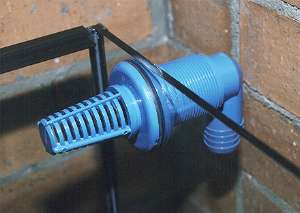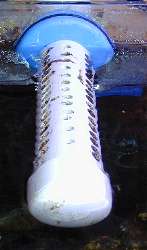
Figure 1: Original bulkhead configuration on Reef 1
When I was planning my 2 Reef tanks back in 1999, I made a huge mistake. After seeing the bulkheads in the back of banks of tanks at one LFS, I thought it would be a good idea. I figured I would not be losing any space in the tank and it would still function as a normal overflow. I was wrong, dead wrong. This article outlines some of the problems with the having the tank drilled at the back and some modifications that can be made to at least get some surface skimming.

Figure 1: Original bulkhead configuration on Reef 1
I see three main problems with using a standard bulkhead and basket in the rear of the tank:
The more frequently used corner overflow box are usually configured so that they can handle a significant head of water over the bulkhead and this allows a good flow of water through the bulkhead. When a tank is drilled on the back pane near the top of the tank, a sufficient head of water is not possible and the flow rate through the bulkhead is limited. Attempting to use a faster sump return pump can result in the tank overflowing. In my case, a Eheim 1250 (1200 L/hr @ 0 head), was too powerful and the tank would overflow. I was only able to go with an Eheim 1048 (600 L/hr @ 0 head). If the tank was drilled slightly lower, the potential to overflow is averted, but water would be drawn depth rather than the surface. This would eliminate surface skimming.
The basket that comes with the bulkhead works to stop organisms, mainly fish from been sucked into the piping, however, it also reduces the flow through the bulkhead and this results in an even greater head of water over the bulkhead, reducing surface skimming even more and also reducing the total flow rate.
I have made two simple modifications and only retain the screw-in bulkhead that seals around the drilled hole. One modification is to make an overflow and the other is to replace the elbow with a 'T'.
To allow for sufficient overflow through the bulkhead, I replaced the basket by a length of 25 mm PVC tubing with an end cap. The tubing can either be drilled or cut near the top so that water overflows at a single level instead of flowing through the basket over a number of centimetres. The choice of drilling versus cutting is dependent on tank inhabitants.
For 50G Reef #1, I drilled a number of 6 mm holes along the length of the tube as the tank includes small fish which may go over a full overflow. I cut the tube to a length of 20 cm and drilled closely spaced 6 mm holes along the length of the tube. I drilled another set of holes at around 90 degrees to the first set of holes. This allows for water to flow from both sides. Finally, I drilled a set of double spaced holes between the other two sets to allow air to flow into the bulkhead. See Figure 2.

Figure 2: The modified overflow pipe on Reef 1.
For my other reef tank (50G Reef #2) I cut the tube instead. This allows for a much better flow but increases the risk of a fish or invertebrate swimming over the overflow. Again I used a 20 cm length of tube and cut to top 5 mm off the tube along the middle 12 cm of the tube. This creates a very efficient overflow. See Figure 3.

Figure 3: The modified overflow pipe on Reef 2.
The new overflows increased surface skimming, however, the flow rate through the bulkhead was still reduced as both air and water had to flow through. I replaced the elbow on the outside of the bulkhead with a 'T' piece so that air enters the piping from the top and only water needs to flow through the bulkhead as shown in Figure 4.

Figure 4: The 'T' piece on the outside of the bulkhead.
The two modifications made huge improvements to surface skimming and the flow rate to the sump. I still can't use a sump return any faster than the Eheim 1048, but at least the tank does not overflow - unless there is a blockage somewhere in the piping.
Last updated: January 1, 2004